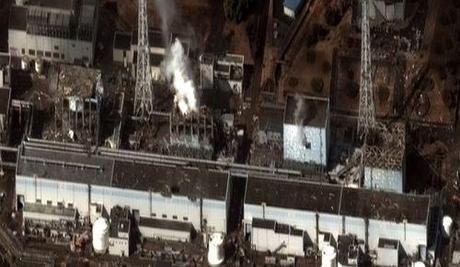On March 11, 2011, a 9.03 magnitude earthquake struck off the northeastern coast of Japan. It was the most powerful known earthquake ever to have hit Japan, and one of the five most powerful earthquakes in the world since modern record-keeping began in 1900.
The earthquake triggered powerful tsunami waves that reached heights of up to 133 ft in Miyako in Tōhoku’s Iwate Prefecture, and which, in the Sendai area, traveled up to 6 mi inland. The earthquake moved Honshu (the main island of Japan) 8 ft east and shifted the Earth on its axis by estimates of between 4 to 10 inches.
 Damaged reactors at the Fukushima Daiichi Nuclear Power Plant
Damaged reactors at the Fukushima Daiichi Nuclear Power Plant
The earthquake and tsunami, in turn, led to a series of equipment failures, nuclear meltdowns, and releases of radioactive materials at the Fukushima Daiichi Nuclear Power Plant.
It is the largest nuclear disaster since the Chernobyl disaster of 1986, and only the second disaster (along with Chernobyl) to measure Level 7 on the International Nuclear Event Scale (INES). This scale runs from 0, indicating an abnormal situation with no safety consequences, to 7, indicating an accident causing widespread contamination with serious health and environmental effects. Prior to Fukushima, the Chernobyl disaster was the only level 7 accident on record, while the Three Mile Island accident was a level 5 accident.
On October 12, 2012, the Tokyo Electric Power Company (TEPCO) that maintains the Fukushima plant, admitted for the first time that it had failed to take stronger measures to prevent nuclear disasters for fear of inviting lawsuits or protests against its nuclear plants.
Now, a nuclear expert at the University of Missouri tells us the Fukushima disaster is even much worse than we’ve been told: There really is no containment because the melted core had cracked the containment vessel.
Nuclear meltdown is an informal term for the accidental melting of the core of a nuclear reactor. A core melt accident occurs when the heat generated by a nuclear reactor exceeds the heat removed by the cooling systems to the point where at least one nuclear fuel element exceeds its melting point. A meltdown is considered very serious because of the potential, however remote, that radioactive materials could breach all containment and escape (or be released) into the environment, resulting in radioactive contamination and fallout, and potentially leading to radiation poisoning of people and animals nearby.
George Washington writes for ZeroHedge, Feb. 27, 2013, that Dr. Steven Starr, who is the director of the Clinical Laboratory Science Program at the University of Missouri and a senior scientist at Physicians for Social Responsibility, says:
“The Japanese basically lied about what happened with the reactors for months. They said they were trying to prevent a meltdown, when in fact they knew within the first couple of days Reactors 1, 2, and 3 at Fukushima Daiichi had melted down, and they actually melted through the steel containment vessels. So there was a worst case scenario that they were trying to hide, they even knew that at that time enormous amounts of radiation were released over Japan and some of it even went over Tokyo [...] The melted core cracked the containment vessel, there really is no containment. So as soon as they pump the water in it leaks out again.”
Asahi Shimbum notes that the location of Fukushima melted fuel is unknown. It could be “scattered” in piping, vessels … “we’ve yet to identify all hotspots” around the plant.
While the Japanese government tried to cover up the lack of containment with “mission accomplished” type announcements of “cold shutdown“, the loss of containment has been known for years.
For example, AP wrote in December 2011:
The nuclear fuel moved as it melted, so its condition and by Text-Enhance"> by Text-Enhance"> by Text-Enhance"> by Text-Enhance"> by Text-Enhance"> by Text-Enhance"> by Text-Enhance"> by Text-Enhance">locations are little known.
AP noted a couple of days later:
The complex still faces numerous concerns, triggering criticism that the announcement of “cold shutdown conditions” is based on a political decision rather than science. Nobody knows exactly where and how the melted fuel ended up in each reactor ….
Washington’s blog noted:
If the reactors are “cold”, it may be because most of the hot radioactive fuel has leaked out.
Indeed, if the center of the reactors are in fact relatively “cold”, it may be because most of the hot radioactive fuel has leaked out of the containment vessels and escaped into areas where it can do damage to the environment.
The New York Times pointed out in November 2011:
A former nuclear engineer with three decades of experience at a major engineering firm … who has worked at all three nuclear power complexes operated by Tokyo Electric [said] “If the fuel is still inside the reactor core, that’s one thing” …. But if the fuel has been dispersed more widely, then we are far from any stable shutdown.”
After drilling a hole in the containment vessel of Fukushima reactor 2, TEPCO could not find the reactor’s melted fuel.
The Fukushima fuel pools continue to be one of the main threats to Japan, the United States … and all of humanity.
And the Fukushima accident is presently causing higher and higher levels of contamination hundreds of miles away … and is still contaminating wildlife thousands of miles away.
~Eowyn

